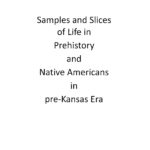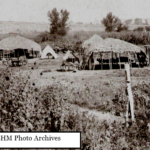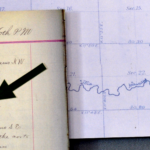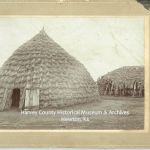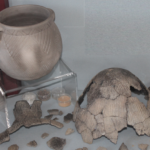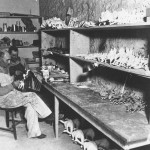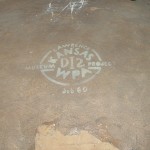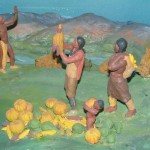Samples of Life in Pre-Kansas Era: Prehistory and Native Americans
For many millennia, Native Americans inhabited the Great Plains of North America. From the 16th century to 18th century, the Kingdom of France claimed ownership of large parts of North America.
In 1803, most of the land for modern day Kansas was acquired by the United States from France at 2.83 cents per acre as part of the 828,000 square mile Louisiana Purchase. In 1848 (after the Mexican-American War), the Treaty of Guadalupe Hidalgo with Spain brought into the United States all or part of the land for ten future states, including southwest Kansas. In 1854, the Kansas Territory was organized. Kansas became the 34th state of the United States in 1861.
Through on-line exhibits, a series of slideshows gives short stories about Harvey County and its cities. Check the website regularly to discover the addition of new on-line slideshows in this series on Harvey County, Kansas.
For even more stories of Harvey County’s people and businesses, check out our blog, “Voices of Harvey County” on the About Us tab.
Click anywhere on the first image below to scroll through Unit 1 — Samples of Life in pre-Kansas Era: Prehistory and Native Americans.
- Click this slide to start Unit One on “Samples of Life in Pre-Kansas Era: Prehistory and Native Americans”
- Columbian Mammoth. Similar in size to today’s African elephant, the mammoth could have tusks up to 14 ft long. During the Late Pleistocene Period, mammoths roamed present-day United States; and as far south as Honduras. The mammoth would typically spend 16 to 18 hours a day feeding or moving toward a food source and water. Image created by Mark Hallett.
- Tooth of Columbian Mammoth. This molar tooth, useful for grinding the grass that was a diet mainstay, was discovered in Harvey County in 1966 during the construction of Interstate Highway I-135. Photo credit: Ronald Dietzel. 2/21/2017
- 1541: Spanish explorer Francisco Vazquez de Coronado documented native grass house villages in the Great Bend region of the Arkansas River. He called the people “the Quivira.” Eventually, two distinct groups were formed: the Wichita and the Pawnee. The Quivira lived in villages throughout central Kansas between the Smoky Hill and Arkansas Rivers.
- In Harvey County, there is evidence of a large Quivira/Wichita village in Alta Township at the convergence of Turkey Creek and the Little Arkansas River. The location is known as “the Alta Mill Site.”
- Wichita Grass house, ca. 1900, Chickasha, Indian Territory. Photo taken by William E. Irwin. HCHM Photo Archives
- Saxman Site in Rice County, Kansas. Partially reconstructed pot and pieces came from an excavation in Rice County. The Saxman site, a large Great Bend aspect village site (which became a National Register listing in 1976), was occupied by the protohistoric Wichita tribe. The shards come from a real pot while the complete one is a reproduction.
- WPA Dioramas, 1939-1941. During the late 1930s, federal Work Projects Administration (WPA) launched numerous federal work-relief programs. One of these was the Kansas Museum Project. It created dioramas for use in public schools. Their purpose was educational; and the scenes were intended to be a realistic depiction of an aspect of Kansas history. Portrayed were episodes from Kansas history and the life of early Indian tribes. Side view of Kansas History Diorama No. 2, Four Horses Trading Post
- Painting diorama figures. There were three workshops where artists created the dioramas. The scenes depicted were Pawnee pottery making, Coronado’s March, Four Horses Trading Post (also known as the Choteau Brothers Trading Fort), and a Kansa Harvest. Each diorama came with labels giving information about the scene being portrayed. Photo courtesy Kansas Memory at http://kansasmemory.org/item/14898
- WPA Logo on the back of the diorama. In 1940 or 1941, the Newton Public Schools purchased five dioramas which were made in the Lawrence, Kansas workshop between 1939 and 1941. By the 1980s, Newton’s dioramas were forgotten after being put into storage at Washington Elementary School. In 1986, the dioramas were uncovered by local art teacher Phil Epp. He put them into use in his classroom at Santa Fe Middle School in Newton. They were used until a 2000 renovation of the school, put into storage for several years, returned to classroom use, placed back into storage, and then donated in 2014 to the Harvey County Historical Museum.
- Detail of Indian Diorama No. 2, Kansa Harvest. Label for the Kansa Harvest diorama reads, “In a typical semi-nomadic tribal scene, the Kansas Indians are heaping their harvest of vegetables before their chief who sits cross-legged outside his earth lodge.”
- This pictorial history unit about Harvey County was compiled by Ronald Dietzel. Acknowledgement – Through their input and suggestions, Kristine Schmucker (HCHM Curator) and Jane Jones (HCHM Archivist) made significant contributions to the compilation of this unit. See more in the on-line series “Short Stories of Harvey County.” View Unit #2 to see “Sketches of Pre-Harvey County and Settlement of the Area” and get an overview of this chapter in Harvey County’s story.


